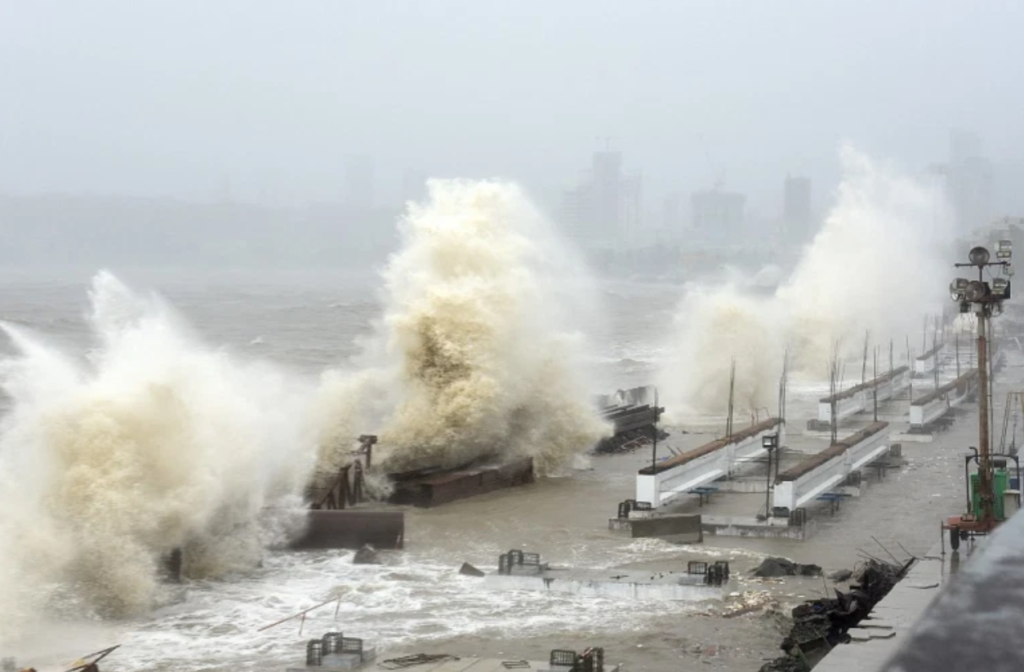Steep increase in sea surface temperatures (SST) intensified the storm significantly. Usual sea surface temperature (SST) in Arabian Sea is around 28°C-29°C, compared to around 31°C when Tauktae developed
India’s west coast was hit by cyclone Tauktae earlier this week. According to news reports from the affected states, at least 57 people were killed as a direct result of the cyclone. The Indian Navy, engaged in rescue operations in the Arabian Sea, reported the recovery of 26 bodies of workers who died as the cyclone sunk ONGC-operated barge off the Mumbai coast. Rescue and recovery operations for another 49 crew members who are still missing at sea.
With the cyclone attaining speeds of up to 185 km/h, the trail of destruction across India’s western coastal states has become clear in the immediate aftermath, including obstruction of crucial healthcare services as states struggle to handle the ongoing second wave of the COVID-19 pandemic. Cyclones, like Tauktae, have become the most devastating extreme weather events faced by India with immense life and property loss reported annually. Recent studies show that frequency and intensity of cyclones developing around the Indian peninsula is likely to increase as average sea surface temperatures trend upwards.

“It is very rare that a cyclonic storm with such high intensity is seen hitting the coast. This indicates the direct impact of global warming. Above threshold sea surface temperatures across Arabian Sea, particularly over east-central and adjoining northeast Arabian Sea that is known for comparatively cooler temperatures, kept on strengthening the Cyclone Tauktae. Thus, the tropical storm which usually degrades to cyclone or deep depression while making landfall, is likely to now sustain the strength of very severe to severe cyclonic storm. This change is here to stay, and we might see more devastating storms in the future,” says Mahesh Palawat, VP of meteorology at Skymet Weather.
Temperature and storm strength
“With Cyclone Tauktae, this will be the fourth consecutive year of pre-Monsoon cyclone over the Arabian Sea. This is also the third consecutive year when a cyclone has come very close to the west coast of India. Sea Surface Temperatures in Arabian Sea have increased rapidly during the past century and this has led to an increase in the frequency and intensity of cyclones in the Arabian Sea,” says Dr Roxy Mathew Koll, Scientist, Indian Institute of Tropical Meteorology, Lead Author, IPCC Oceans and Cryosphere. “Cyclones are fueled by available heat in the waterbodies. Conducive temperature for the intensification of the cyclone is 28°C and above. The Bay of Bengal is usually warmer than Arabian Sea and thus, hosts more number of tropical storms. However, the scenario is now changing as we have seen SST temperatures increasing rapidly in the last century,” he adds.

As a result, SSTs in the Arabian Sea are over the threshold values. These warmer temperatures are indicative of active convection, torrential rainfall, and intense cyclones. The same has been witnessed during the development of Tauktae with several locations on the west coast reporting widespread three-digit rainfall levels and flood-like situations.
Globally, ocean temperatures have increased as a result of climate change – and there has been a correlated increase in the observed intensity of the strongest storms over recent decades. Cyclone Tauktae has confirmed this trend, finding that the proportion of the strongest storms is increasing about 8% a decade. These higher sea-surface temperatures increased the energy available to the storm.
Rapid intensification
Fuelled by elevated temperatures, cyclones are also reportedly intensifying more rapidly than earlier. Recent cyclones like Ockhi, Fani, and Amphan have confirmed this trend as they intensified from a ‘weak cyclonic storms’ to ‘extremely severe cyclones’ in less than 24 hours.
Rapid intensification is expected to continue to become much more frequent this century with continued climate change. One study found that intensification rates that happen once a century now could happen every 5-10 years by 2100.
This kind of rapid intensification has posed serious challenges to forecasting capacity. Officials are unable to give quick response as they are not able to judge the ocean dynamics accurately. Thus, we need to change the way of thinking as well as gauging the situation accordingly, adds Koll.
“Efficient forecasts require efficient monitoring of the ocean, but we have gaps there too. We can monitor and track these cyclonic systems through the buoys and instruments in the oceans, satellites in the sky, and weather models running on high-performance computers. Global warming has presented us with new challenges such as rapid intensification of cyclones, which need to be closely monitored at higher resolution and accuracy using on-site platforms such as buoys and moorings. Improving the Indian Ocean Observing System (IndOOS) and incorporating the global warming signals in the weather models can help us tackle the challenges of intense cyclones in the future,” explains Koll.
About The Author
You may also like
With record breaking rain and heat, Uttarakhand reels under climate change impacts
Growing climate risks to India Inc call for a mindset shift, building resilience: Experts
Philippines island faces risk of heavy rainfall which is now 50% more intense, along with deadly landslides : WWA report
Seafood to lose nutritional value due to climate change: Study
14.5 million lives may be lost by 2050 due to climate change: WEF report


